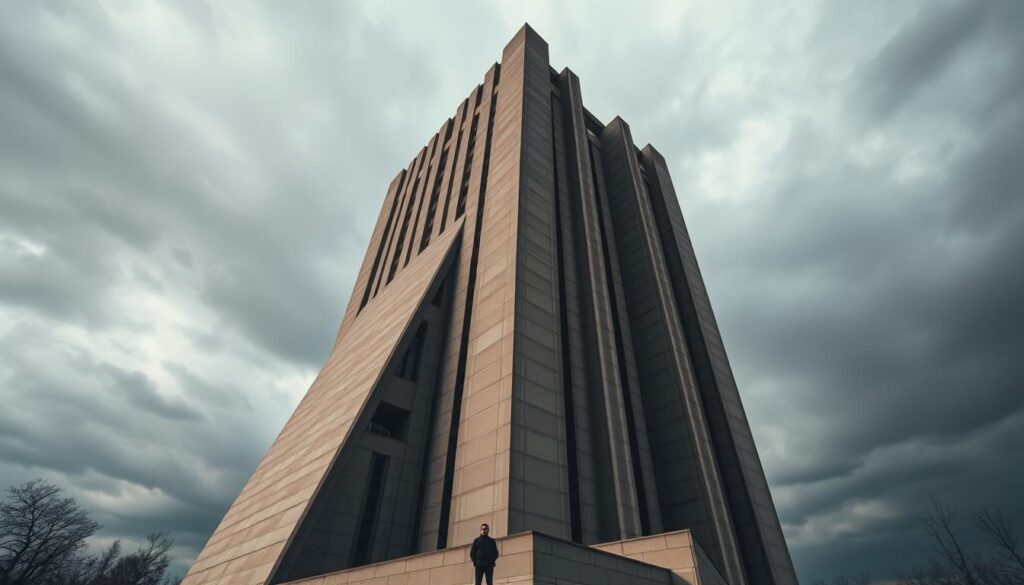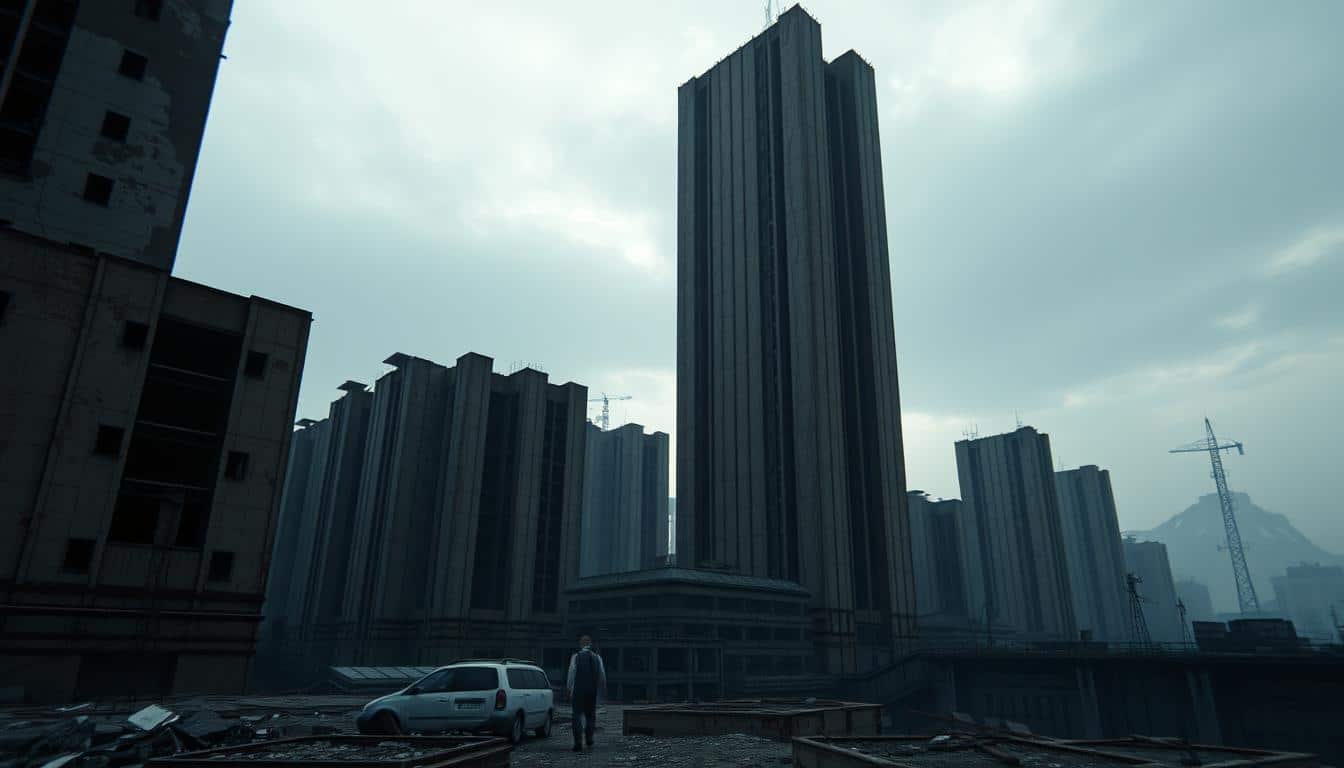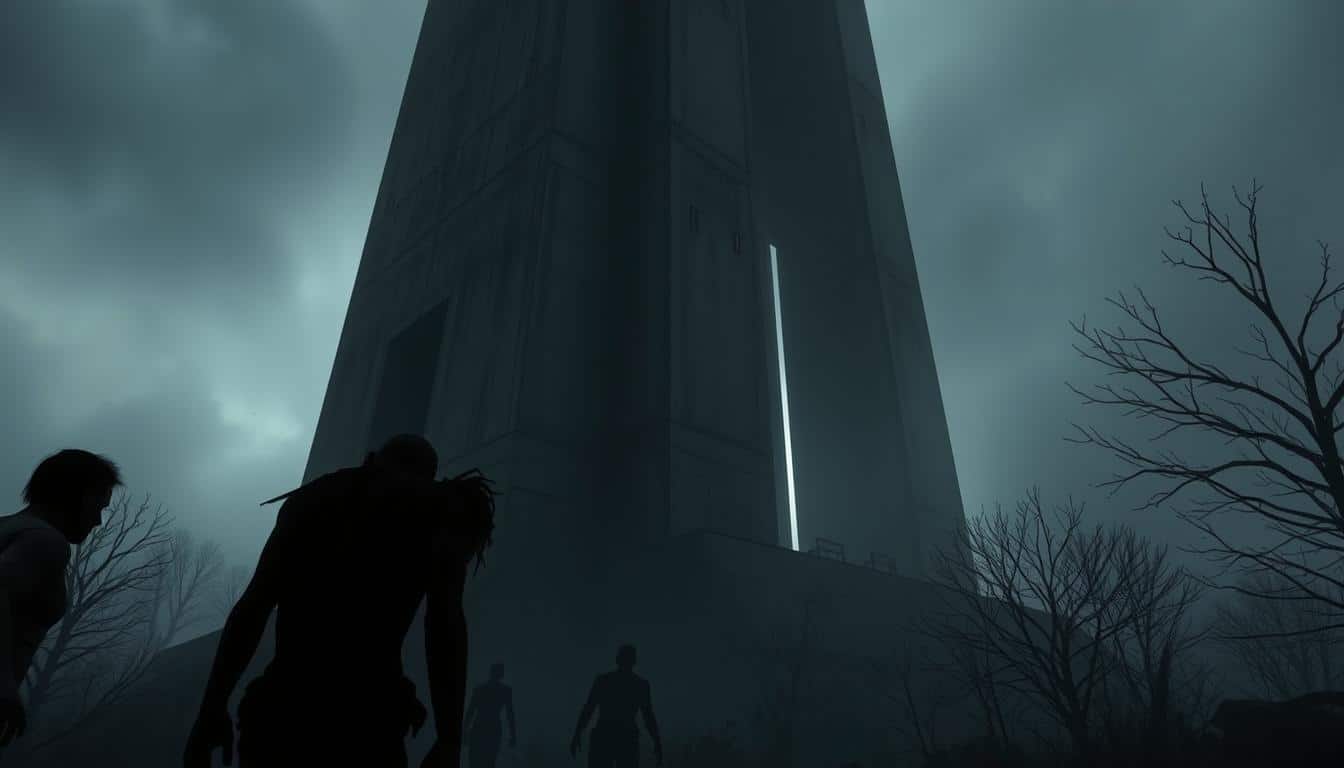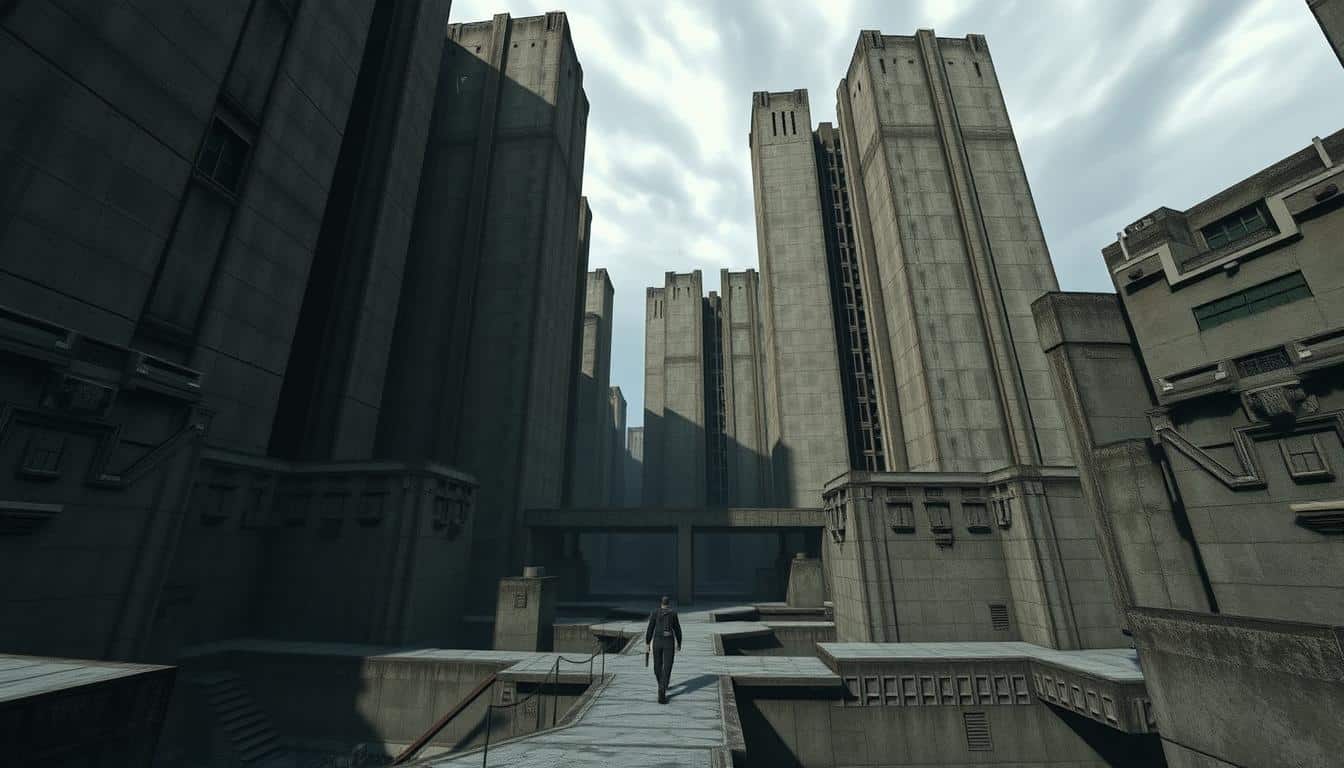Soviet brutalism is a powerful marker of a unique historical era. It’s known for its stark concrete look. This style came about to meet the needs of its time, leaving us with grand buildings in our cities. Now, blending Soviet brutalism with the digital world opens new doors. We get to reimagine these old giants through tech. This journey shows how tech makes old architecture come alive. It lets modern people connect with these famous structures in new ways.
Introduction to Soviet Brutalism
Soviet brutalism is a unique window into mid-20th century architectural trends. It rose from the social and political climate of the Soviet Union. It aimed to show equality and community living through simple, useful designs. This architectural style reflects the tough, resilient life back then.
Stark concrete buildings showed the era’s spirit. These structures are not just about new architectural ideas. They also reflect the social and political beliefs of their time. The blend of art and politics is clear. These buildings tell stories about society and working together.
When we look into brutalism, we see both love and critique for these large buildings. Their bold look can make people feel many things, from awe to unease. Digging into Soviet brutalism’s roots and effects helps us get why it still matters in architecture today.

The Aesthetic of Soviet Brutalist Architecture
Brutalism comes from the French ‘béton brut’ meaning ‘raw concrete.’ This style focuses on using materials like concrete in their natural form. It values ruggedness and practical uses over fancy decorations. Figures like Alison and Peter Smithson were pivotal in shaping this philosophy, influencing architects globally.
Defining Brutalism: A Focus on Raw Concrete
Brutalism truly embraces the raw aspect of concrete. This approach shows strength and stays true to the material’s essence. It aimed to make buildings that are straightforward in their structure. This focus on simple honesty in materials led to iconic, large constructions during the Soviet era. These structures were practical and groundbreaking.
Key Characteristics of Soviet Brutalism
Soviet Brutalism is recognized by specific features:
- Bold geometric forms that create a sense of solidity and permanence.
- Exposed raw concrete surfaces that highlight the basic textures and colors of the material.
- A functional design that serves the needs of the community rather than seeks aesthetic superficiality.
- A monumental scale often associated with public buildings, conveying authority and durability.
Why Soviet Brutalism Matters Today
The importance of brutalism in modern architecture shows how our appreciation for it has grown. Now, as architecture changes, the interest in these big, bold buildings is rising. This shows a new conversation about what buildings mean to us and their role in our culture. More people and groups are seeing the unique beauty in brutalist designs. They’re talking about why we should keep these buildings and their place in our cities today.
Fans of architecture like the rough textures and strong shapes of Soviet-era buildings. Social media helps fuel this interest by sharing amazing pictures of these structures. These sites are where people celebrate these buildings but also debate their impact. It shows how different views on brutalism are part of our culture today.
To understand the importance of Soviet brutalism, we need to look at what it means for our cultural heritage. These buildings remind us of a specific time and way of thinking. They make us think about the history of architecture and how it’s changing. Brutalism shows us how past designs can influence future architecture.
Cultural Context of Soviet Brutalist Structures
The post-war era was a turning point for Soviet architecture. Cities and communities needed rebuilding after World War II. This period saw a move towards practical designs and social duty. Soviet brutalism responded to these needs, mixing the Communist state’s values with society’s changing demands.
Brutalism in the Post-War Era
After the war, there was a big push for shared living spaces. Architects aimed to create affordable, efficient housing. Soviet brutalist buildings are known for:
- Raw concrete as a primary material
- Functional designs that prioritized utility
- Open spaces encouraging community interaction
These features helped build communities. They brought people together, strengthening collective identity and reflecting the era’s culture.
Impact of Political Ideologies on Architecture
Political beliefs deeply influenced Soviet Union’s architecture. Social realism influenced design, aiming to show communism’s benefits. This led to buildings that met people’s needs while symbolizing state goals. The architectural story of that time included:
- State-sponsored projects that prioritized public spaces
- Symbolism in design deepening ideological messages
- Architectural movements aiming to break from Western styles
Thus, architecture became a way to show the Soviet Union’s cultural ideals, aims, and the complexity of a war-recovering society entering a new ideological phase.
Exploring Soviet Brutalist Structures in Digital Landscapes
Digital technology opens new doors for seeing Soviet brutalist architecture in immersive digital worlds. Now, we can explore these famous buildings beyond the limits of the real world. With augmented reality and advanced software, we can dive into their design and history.
This tech also lets us save and share these architectural gems in a digital space. People all over the globe can admire Soviet Brutalism without leaving their homes. The digital models bring out the raw beauty of these buildings in an exciting way.
The bond between technology and architecture grows stronger as we digitally showcase Soviet brutalist buildings. Exploring these spaces online renews interest in this style of architecture. It helps us understand and value its influence on culture.
The Digital Reimagining of Historic Structures
Digital tools have changed how we see architecture, especially Soviet Brutalism. Artists and architects now use AI to reimagine old buildings in creative ways. With programs like MidJourney and DALL-E, they turn concrete structures into digital art. This mix of tech and design makes brutalism’s unique look more known today.
AI-Generated Images: Capturing Brutalism
AI transforms the often-missed beauty of brutalist architecture into striking images. These tools turn ideas into visuals that highlight concrete’s raw appeal. Bringing AI images into talks about Soviet designs shows off their complexity and value. It gives people a new way to see how digital art can connect us to history and design.
Virtual Reality and Architectural Exploration
Virtual reality lets people explore famous buildings from the inside. It offers a unique view of brutalism’s spatial designs. By moving through digital models, users learn about architectural fundamentals. This tech proves the lasting impact of Soviet Brutalism, inspiring and teaching future designers.
Famous Soviet Brutalist Buildings and Their Digital Depictions
Famous Soviet brutalist buildings are very important in both history and art. Places like the Palace of Culture and Science in Warsaw and Moscow’s VDNH are getting noticed more thanks to digital methods. These buildings are more than just big structures. They are also key pieces of history, shown in new, exciting ways.
Documentation of Structures through Digital Art
Digital art helps keep the greatness of these buildings alive. It uses 3D models, virtual tours, and amazing visual art. This approach offers a fresh view of their designs and histories.
Artists and historians work together to remember these iconic buildings. They let people see their importance from different angles.
Case Study: The National Theatre as a Digital Canvas
The National Theatre shows the impact of digital media on Soviet brutalism. Artists use cool methods to make this building stand out. By focusing on its unique design, digital art shows its impressive size and style.
This helps people understand the skill and ideas behind such structures. Viewing it through digital media, the viewers learn more about what makes these buildings special.
Modern Renovations and the Digital Narrative
The trend of modern renovations gives old Soviet buildings new purposes. This method changes out-of-date buildings into lively places. It keeps their history alive. Developers all over the world manage to keep sustainability and cultural respect in these updates.
Adaptive Reuse of Brutalist Buildings
Adaptive reuse shows how brutalist buildings can meet today’s needs. Many projects keep the old looks but add new uses. Examples of this trend include:
- The change of an old factory into a community arts center.
- Turning a no-longer-used office building into homes and shops.
- Making university buildings more student-friendly.
The Role of Developers in Preservation
Developers are key to saving modern brutalism with careful updates. They blend respect for history with new needs. Working with architects and historians, they keep changes sensitive to the original style. This shows a mix of new ideas and keeping the old, a common theme in city development.
Social Media’s Influence on the Brutalist Revival
Social media has had a big impact on architecture, especially the brutalism revival. Sites like Instagram and Pinterest show off brutalist buildings’ bold beauty to the world. This has helped more people appreciate these unique buildings, which were once ignored.
People use hashtags and feeds to share photos of brutalist buildings’ concrete shapes and lines. This online sharing leads to chats about architecture. It lets people bond over their love for brutalism. Social media makes it easy for everyone to learn about and enjoy brutalist designs.
Digital photography trends are key to brutalism’s popularity comeback. Filters and editing make regular photos into eye-catching art. This has helped tell the story of brutalism in a new light. It even makes architects and builders think twice about these often-overlooked buildings.
Influence of Brutalism on Contemporary Architecture
The impact of brutalism on today’s architecture is huge. Architects now use its strong features in their designs. They use raw materials like concrete and steel to make bold buildings. These buildings remind us of designs from the mid-20th century. You can see this trend in cities around the world. New buildings show off the simplicity and functionality that brutalism is known for.
Today’s architects really value brutalism’s bold shapes and expressive features. Designers like David Adjaye and Zaha Hadid mix these brutalist elements into their modern projects. Their innovative designs connect the past with new ideas. They prove that brutalism still plays a big role in shaping today’s architecture.
As design trends change, brutalism’s ideas offer a solid base for innovation. Mixing brutalism with green practices can change the way we see our cities. This mix of old and new shows how important brutalism is in modern architecture. It makes sure brutalism’s ideas keep inspiring us.
Conclusion
Our study delves into Soviet brutalist structures within digital worlds, showing their toughness and importance. These concrete giants, once seen as old symbols, are kept alive with new tech. This tech not only shows off their raw beauty but also tells of their history.
Looking ahead, brutalism has a future as cultural markers and art subjects online. Mixing brutalism with digital experiences lets new folks understand and enjoy what these buildings mean.
Digital advancements offer a great chance to keep brutalism known and understood. Through digital ways, we help ensure these massive works remain a part of our culture. This enriches our architectural legacy for the future.



